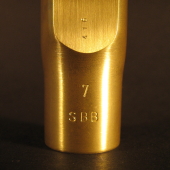G'day to one and all!
This is a pretty contentious issue. The main reason that I bring you this latest update is that the general mouthpiece public is not well informed, and sometimes good people will make bad decisions.
To begin with, I would like to briefly talk about different mouthpiece materials.
For each excellent material currently being utilized in manufacture by my direct competitors, there are literally dozens of materials that:
1. Don't resonate at a frequency which is conducive to a synergistic tonal enhancement of the saxophone;
2. Are too soft, and therefore cannot hold the high tolerances that are so necessary for a long-life mouthpiece product;
3. Are classified as potentially harmful, but nonetheless are still being used;
4. Cannot be finished, plated or are not enough corrosion resistant to allow a saleable product.
Amongst the best hard rubber materials, the choice would have to be the Morgan Hard rubber.
And you guessed correctly if you already thought that the Zagar Bronzes are very special materials - all four negative criteria are successfully alleviated, and the Zagar Bronze metals are therefore able to be used in a saxophone mouthpiece - without compromise.
Now, here's the interesting part: Can the same finishing techniques that are relevant for Bronze, be applied to hard rubber, and vice versa?
The answer is not a simple yes. Firstly, it must be clearly understood by the prospective refacer that the Internal Resonance Coefficient (IRC) is entirely different for both of these excellent materials, and therefore the facing curve will need to be different, in order to match each material.
The prospective refacer should also realize that various hard rubber compounds will each have their own unique IRC number. Therefore each compound/material variation will be required to be matched with the appropriate facing curve 'correction' inter alia, otherwise the mouthpiece simply will not work, period!
As the late great Mr Morgan had once told me, '... the facing curve must be accurate to within 1/10,000th of an inch!...'. Mr Morgan was not only correct about this, but also knew the importance of a relevant facing curve that matched his own world-famous rubber formula.
To this end, if you are in doubt as to whether you should entrust your valuable zagarsax mouthpiece investment to a prospective refacer, ask this same refacer whether he/she has had any experience with the material that he/she is undertaking to work on.
Internal Resonance Coefficient (IRC) is a major factor that must be fully examined, evaluated and understood prior to any refacing work, on any sax mouthpiece. I hope that the above has been of some help to one and all, and please feel welcome to submit your mouthpiece questions via this Contact Us link.
Kindest regards, Dave
|

